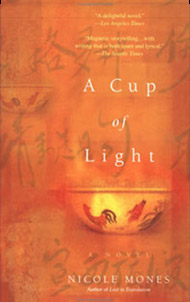
When a young porcelain expert flies to China to evaluate a collection of artwork up for international sale, she lands in circumstances vastly different from what she expected. Lia Frank finds greed, deception, and political turbulence instead of clarity when she tries to learn the origin of a huge collection of priceless porcelains. From the slightly shady Hollywood Road antique district in Hong Kong, to the professional underworld smugglers who move art illegally out of the mainland; from the rich Western art lovers who don’t ask questions, to the Chinese museum officials who want to bring back every piece taken out by Western marauders, each player in the game carries his own secret. It’s Lia’s job to find the truth. As she sorts out the puzzle and uncovers the true history of the collection, she also yearns to have a relationship with more than an inanimate work of art. As the story unfolds, she gets her chance.
Bonus
How did you learn so much about Chinese porcelain? Do you have an art history background?
No, I don’t. Just before I started writing this book, a Chenghua chicken cup was sold at a Sotheby’s auction for $3.75 million. I set out to understand why on earth anyone would pay so much for a small porcelain cup.
To answer this question, I went to the experts. I enlisted the help of Mee Seen Loong, a top porcelain expert with Sotheby’s in Hong Kong. She first guided me through the selection of art books. I think I earned her respect by actually READING the books, for then she took me under her wing. We went to auctions and previews, we visited porcelain dealers in their back rooms, and she introduced me to the shadow world of the porcelain smugglers who figure so prominently in the book. At every turn she helped me visualize what Lia would see. Most important, just by being around Mee Seen I began to understand how a porcelain-obsessed person will think. In fact, I started to think that way myself!
But there were so many details in the book.
All of them are real. Once I had a draft manuscript, Mee Seen and her colleagues practically adopted its accuracy as a pet project. She read through the draft twice and with the help of her fellow appraisers combed through for inaccuracies. When it came to talking about pots, these experts often suggested better or more interesting examples than the ones I had chosen. So you may rest assured that some of the world’s top porcelain minds have ensured the veracity of the novel’s backdrop. Sometimes they even faxed pages to London to have selected details reviewed by the world’s greatest living authority on the porcelains of the Chenghua reign. And some of the little details in the book, like the teenagers in Jingdezhen turning out to be the master painters, came directly from their experiences and the anecdotes they told me.
So this means the portrayal of the smugglers is real?

Completely real. I was very proud of that. After interviewing multiple people who did business with the smugglers on the Hong Kong end, I went to Jingdezhen in China’s Jiangxi Province – which has been the center of Chinese porcelain making for a thousand years. There I interviewed academics, porcelain artists, and dealers. They gave me an account of the smuggler subculture which perfectly matched what I had been told in Hong Kong. Local people in Jingdezhen also helped me locate the favored ah chan hangouts, so I was able to see them and even eavesdrop on them when they were not reverting to their provincial dialects (a preponderance of ah chans seem to be Hunanese). The portrait of Jingdezhen – the town and the people in it – is absolutely as accurate as I could make it. Even some of the dialogue spoken by the artists and academics in Jingdezhen, as well as some of the bawdy language of the ah chans, is lifted directly from things I heard people say.
Why did you decide to make Lia Frank’s memory training – her mnemonic skills – a cornerstone of her character?
This was risky, but I much wanted to portray – in real time – the flight of China’s imperial art collection. This is one of those real-life historical dramas which is all but unknown in the West. As the Japanese approached Peking in the 1930s, Chinese officials frantically packed up 640,000 of the 1,000,000 masterpieces then in the Forbidden City – an art collection which had been continuously built for 1100 years. It is hard for Westerners to appreciate how very important protection of this art would have been to the Chinese as they faced invasion by a foreign power. Art in China does not reflect or evoke the past; it is the past. He who holds the nation’s artistic legacy holds its cultural patrimony. The art collection, split into three parts for safety, was hidden and spirited around China for years – always in the hands of the Nationalists. Japan surrendered in 1945 and the civil war raged on. When the Nationalists finally lost to the Communists in 1949, they fled to Taiwan and took the imperial art collection with them. Huge numbers of people had given their all to keep the art safe. It’s a great romance.
So I very much wanted to tell this story within the novel, but how? None of the characters in the book were alive then; none could hold it in memory. I felt bored with all those old conventions for solving this problem, such as finding a manuscript or a stack of letters in a drawer. I decided to make Lia a mnemonist, someone who is able to retain and access incredible amounts of information and knowledge. This way the full story of the flight of the collection could play in her mind. In the novel it seems almost like a supernatural ability, but it is not. Great feats of memory were much more commonplace prior to the advent of the printing press. When mental retention was pretty much the only way for people to hold onto things, certain people were able to develop phenomenal memories. King Cyrus of Persia knew tens of thousands of soldiers by their first names; King David was said to be able to administer the law in more than twenty languages. The famed 16th C Italian missionary to China, Matteo Ricci, won the favor of the emperor by sitting in court and listening to a three-hour recitation of Tang Dynasty poetry, and then reciting it himself – backwards! However, since feats of memory like this have been out of fashion for some centuries, and data is now stored in other ways, I knew most readers would find this skill unusual.
Why did you choose to make Lia deaf?

That actually came about because of the mnemonics. It was a bit hard at first for readers to go along with such an unusual skill. Early readers of the novel complained that Lia was not a believable character; some said they didn’t like her because she was too smart. I suspected that these readers were having trouble swallowing her preternatural mnemonic skills. So I took away one of her senses. Suddenly, it was all right for her to be a mnemonist. Readers no longer minded her high level of accomplishment with memory. As a bonus, I really liked working with this quality. Research with audiologists and hearing experts brought me to the realization that some people who are born deaf really do not want to hear, at least not all the time, and that seemed to fit her perfectly.
Purchase Book
Reviews
A delightful novel.
– Los Angeles Times
Mones’ knowledge of porcelain is vast, but is worn lightly. Themes of desire and possession, and characters tested by their suffering and loss within those desires, make this novel compelling.
– Sydney Morning Herald
Magnetic storytelling…A Cup of Light has the rare distinction of bringing together an entertaining sequence of just-suspenseful-enough events with writing that is both spare and lyrical.
– The Seattle Times
An excellent novel with a likable heroine immersed in an exotic world of smugglers, forgers, and mysterious collectors. An attractive blend of detective fiction and romance, enriched by considerable erudition concerning Imperial Chinese art.
– The Age (Melbourne)
Mones’ informed perspective on Chinese culture gives substance to what is already an aesthetically brilliant piece of art in itself.
– The Asian Reporter


